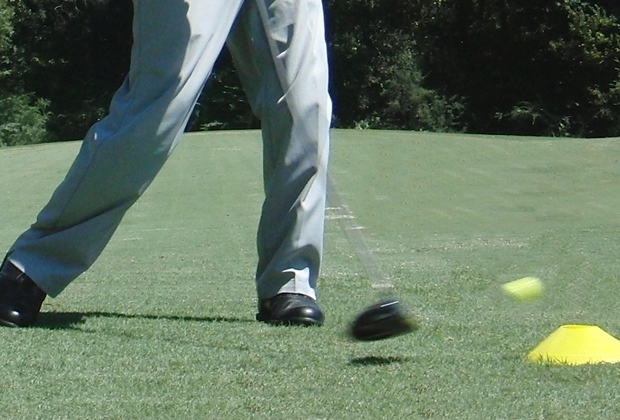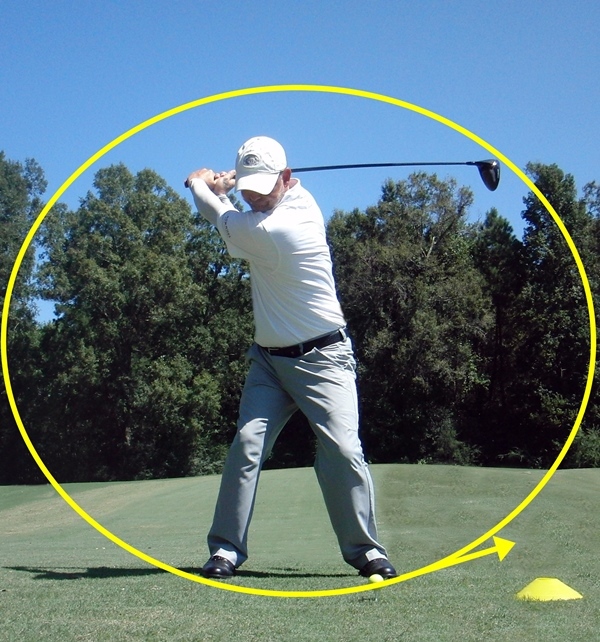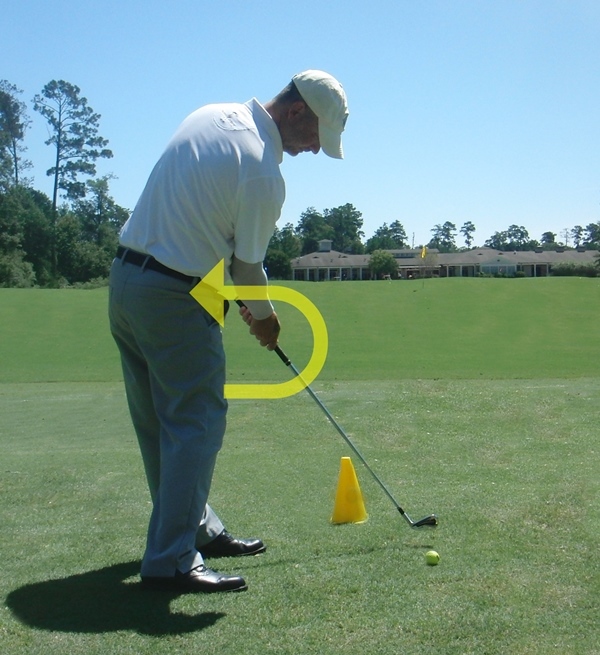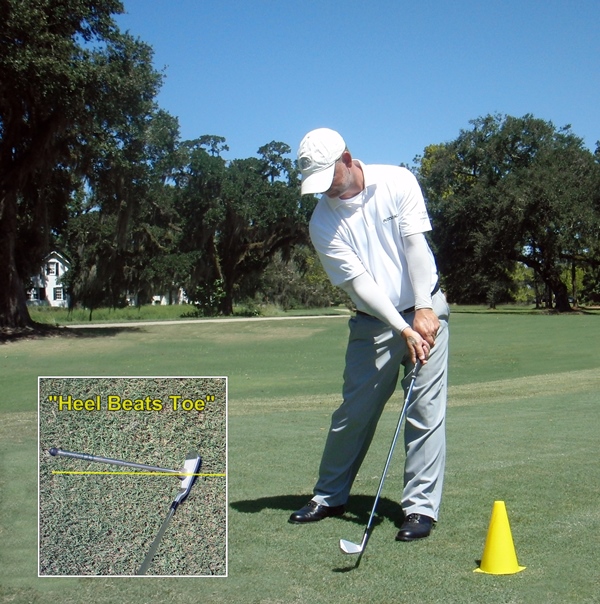Instruction
How to feel your swing fix

I keep a collection of swing images and associated feels on hand to facilitate subtle adjustments for advanced players’ launch monitor data and ball flight. Let us define an “advanced player” as one who possesses a solid setup, consistent face strike and good coordination of in-swing movements. These players generally do not require dramatic mechanical changes and can quickly benefit from the well-defined images and task below.
Shallowing AoA (Angle Of Attack)
Advanced players can often struggle hitting down too steeply with their short irons and wedges.
Feel: Most of us have tinkered with our swings while indoors, so I ask the players to take a wedge and make a few rehearsal swings. The players should feel a nice, shallow brush as if swinging on their living room carpet. I remind them, “You can brush the carpet, but you had better not take a chunk out of it!” Feel this, then apply. The angle of attack number will become more shallow and strike will improve.
Players can also hit down too much with their driver. An image that I like is placing an agility cone in front of the ball; then feel as if the club head is ascending along the inclined angle of the cone. Feeling like you are set up and swinging a bit “uphill” is another great sensation to achieve positive AoA with the driver.
Neutralizing an outward path
Advanced players can hit hooks and blocks from their path moving too much outward, or traveling too much from inside-out in relation to the target line.
Feel: I place a taller cone inside the target line and about 2 feet in front of the impact area. I then ask the players to make a swing and feel as though they will knock the cone over. Sometimes the image is all that is needed, but sometimes we make practice swings while actually hitting the cone. Swing path and direction will quickly improve.
Tweaking face-to-path relationship
Most golfers tend to be good at making adjustments to their swing path. Consistently controlling the club face, however, is a bit more challenging. I see many advanced players who struggle with misdirected shots that draw too much or too quickly.
Feel: I want you to imagine a race to impact in which the heel of the club wins. “Heel beats toe!” is the mantra. This image works well in conjunction with our cone drill. Rotate the chest open and the hands inward to give the heel the advantage of winning.
Conclusion
Check your pre-swing fundamentals, then give these fixes a try. For advanced players, a little bit goes a long way, so pay close attention to your ball flight and/or measurement device to determine just the right amount for you.
- LIKE120
- LEGIT17
- WOW4
- LOL6
- IDHT2
- FLOP2
- OB0
- SHANK13
Instruction
The Wedge Guy: The easiest-to-learn golf basic

My golf learning began with this simple fact – if you don’t have a fundamentally sound hold on the golf club, it is practically impossible for your body to execute a fundamentally sound golf swing. I’m still a big believer that the golf swing is much easier to execute if you begin with the proper hold on the club.
As you might imagine, I come into contact with hundreds of golfers of all skill levels. And it is very rare to see a good player with a bad hold on the golf club. There are some exceptions, for sure, but they are very few and very far between, and they typically have beat so many balls with their poor grip that they’ve found a way to work around it.
The reality of biophysics is that the body moves only in certain ways – and the particulars of the way you hold the golf club can totally prevent a sound swing motion that allows the club to release properly through the impact zone. The wonderful thing is that anyone can learn how to put a fundamentally sound hold on the golf club, and you can practice it anywhere your hands are not otherwise engaged, like watching TV or just sitting and relaxing.
Whether you prefer an overlap, interlock or full-finger (not baseball!) grip on the club, the same fundamentals apply. Here are the major grip faults I see most often, in the order of the frequency:
Mis-aligned hands
By this I mean that the palms of the two hands are not parallel to each other. Too many golfers have a weak left hand and strong right, or vice versa. The easiest way to learn how to hold the club with your palms aligned properly is to grip a plain wooden ruler or yardstick. It forces the hands to align properly and shows you how that feels. If you grip and re-grip a yardstick several times, then grip a club, you’ll see that the learning curve is almost immediate.
The position of the grip in the upper/left hand
I also observe many golfers who have the butt of the grip too far into the heel pad of the upper hand (the left hand for right-handed players). It’s amazing how much easier it is to release the club through the ball if even 1/4-1/2″ of the butt is beyond the left heel pad. Try this yourself to see what I mean. Swing the club freely with just your left hand and notice the difference in its release from when you hold it at the end of the grip, versus gripping down even a half inch.
To help you really understand how this works, go to the range and hit shots with your five-iron gripped down a full inch to make the club the same length as your seven-iron. You will probably see an amazing shot shape difference, and likely not see as much distance loss as you would expect.
Too much lower (right) hand on the club
It seems like almost all golfers of 8-10 handicap or higher have the club too far into the palm of the lower hand, because that feels “good” if you are trying to control the path of the clubhead to the ball. But the golf swing is not an effort to hit at the ball – it is a swing of the club. The proper hold on the club has the grip underneath the pad at the base of the fingers. This will likely feel “weak” to you — like you cannot control the club like that. EXACTLY. You should not be trying to control the club with your lower/master hand.
Gripping too tightly
Nearly all golfers hold the club too tightly, which tenses up the forearms and prevents a proper release of the club through impact. In order for the club to move back and through properly, you must feel that the club is controlled by the last three fingers of the upper hand, and the middle two fingers of the lower hand. If you engage your thumbs and forefingers in “holding” the club, the result will almost always be a grip that is too tight. Try this for yourself. Hold the club in your upper hand only, and squeeze firmly with just the last three fingers, with the forefinger and thumb off the club entirely. You have good control, but your forearms are not tense. Then begin to squeeze down with your thumb and forefinger and observe the tensing of the entire forearm. This is the way we are made, so the key to preventing tenseness in the arms is to hold the club very lightly with the “pinchers” — the thumbs and forefingers.
So, those are what I believe are the four fundamentals of a good grip. Anyone can learn them in their home or office very quickly. There is no easier way to improve your ball striking consistency and add distance than giving more attention to the way you hold the golf club.
More from the Wedge Guy
- The Wedge Guy: Golf mastery begins with your wedge game
- The Wedge Guy: Why golf is 20 times harder than brain surgery
- The Wedge Guy: Musings on the golf ball rollback
- LIKE85
- LEGIT13
- WOW6
- LOL1
- IDHT0
- FLOP4
- OB1
- SHANK8
Instruction
Clement: Stop ripping off your swing with this drill!

Not the dreaded headcover under the armpit drill! As if your body is defective and can’t function by itself! Have you seen how incredible the human machine is with all the incredible feats of agility all kinds of athletes are accomplishing? You think your body is so defective (the good Lord is laughing his head off at you) that it needs a headcover tucked under the armpit so you can swing like T-Rex?
- LIKE0
- LEGIT2
- WOW2
- LOL0
- IDHT0
- FLOP0
- OB0
- SHANK2
Instruction
How a towel can fix your golf swing

This is a classic drill that has been used for decades. However, the world of marketed training aids has grown so much during that time that this simple practice has been virtually forgotten. Because why teach people how to play golf using everyday items when you can create and sell a product that reinforces the same thing? Nevertheless, I am here to give you helpful advice without running to the nearest Edwin Watts or adding something to your Amazon cart.
For the “scoring clubs,” having a solid connection between the arms and body during the swing, especially through impact, is paramount to creating long-lasting consistency. And keeping that connection throughout the swing helps rotate the shoulders more to generate more power to help you hit it farther. So, how does this drill work, and what will your game benefit from it? Well, let’s get into it.
Setup
You can use this for basic chip shots up to complete swings. I use this with every club in my bag, up to a 9 or 8-iron. It’s natural to create incrementally more separation between the arms and body as you progress up the set. So doing this with a high iron or a wood is not recommended.
While you set up to hit a ball, simply tuck the towel underneath both armpits. The length of the towel will determine how tight it will be across your chest but don’t make it so loose that it gets in the way of your vision. After both sides are tucked, make some focused swings, keeping both arms firmly connected to the body during the backswing and follow through. (Note: It’s normal to lose connection on your lead arm during your finishing pose.) When you’re ready, put a ball in the way of those swings and get to work.

Get a Better Shoulder Turn
Many of us struggle to have proper shoulder rotation in our golf swing, especially during long layoffs. Making a swing that is all arms and no shoulders is a surefire way to have less control with wedges and less distance with full swings. Notice how I can get in a similar-looking position in both 60° wedge photos. However, one is weak and uncontrollable, while the other is strong and connected. One allows me to use my larger muscles to create my swing, and one doesn’t. The follow-through is another critical point where having a good connection, as well as solid shoulder rotation, is a must. This drill is great for those who tend to have a “chicken wing” form in their lead arm, which happens when it becomes separated from the body through impact.
In full swings, getting your shoulders to rotate in your golf swing is a great way to reinforce proper weight distribution. If your swing is all arms, it’s much harder to get your weight to naturally shift to the inside part of your trail foot in the backswing. Sure, you could make the mistake of “sliding” to get weight on your back foot, but that doesn’t fix the issue. You must turn into your trial leg to generate power. Additionally, look at the difference in separation between my hands and my head in the 8-iron examples. The green picture has more separation and has my hands lower. This will help me lessen my angle of attack and make it easier to hit the inside part of the golf ball, rather than the over-the-top move that the other picture produces.


Stay Better Connected in the Backswing
When you don’t keep everything in your upper body working as one, getting to a good spot at the top of your swing is very hard to do. It would take impeccable timing along with great hand-eye coordination to hit quality shots with any sort of regularity if the arms are working separately from the body.
Notice in the red pictures of both my 60-degree wedge and 8-iron how high my hands are and the fact you can clearly see my shoulder through the gap in my arms. That has happened because the right arm, just above my elbow, has become totally disconnected from my body. That separation causes me to lift my hands as well as lose some of the extension in my left arm. This has been corrected in the green pictures by using this drill to reinforce that connection. It will also make you focus on keeping the lead arm close to your body as well. Because the moment either one loses that relationship, the towel falls.


Conclusion
I have been diligent this year in finding a few drills that target some of the issues that plague my golf game; either by simply forgetting fundamental things or by coming to terms with the faults that have bitten me my whole career. I have found that having a few drills to fall back on to reinforce certain feelings helps me find my game a little easier, and the “towel drill” is most definitely one of them.
- LIKE12
- LEGIT2
- WOW2
- LOL0
- IDHT0
- FLOP2
- OB0
- SHANK8
-

 19th Hole1 week ago
19th Hole1 week agoDave Portnoy places monstrous outright bet for the 2024 Masters
-

 19th Hole3 weeks ago
19th Hole3 weeks agoThings got heated at the Houston Open between Tony Finau and Alejandro Tosti. Here’s why
-

 19th Hole1 week ago
19th Hole1 week agoTiger Woods arrives at 2024 Masters equipped with a putter that may surprise you
-

 19th Hole2 weeks ago
19th Hole2 weeks agoReport: Tiger Woods has ‘eliminated sex’ in preparation for the 2024 Masters
-

 19th Hole5 days ago
19th Hole5 days agoTwo star names reportedly blanked Jon Rahm all week at the Masters
-

 19th Hole4 days ago
19th Hole4 days agoNeal Shipley presser ends in awkward fashion after reporter claims Tiger handed him note on 8th fairway
-

 19th Hole3 days ago
19th Hole3 days agoReport: LIV Golf identifies latest star name they hope to sign to breakaway tour
-

 19th Hole2 weeks ago
19th Hole2 weeks agoAddiction, spinal fusion, and scam artists – Everything Anthony Kim revealed in candid interview with David Feherty


















RT
Oct 1, 2015 at 7:30 pm
GREAT stuff, Michael! Keep it coming!
Michael Howes
Oct 1, 2015 at 9:34 pm
Glad u enjoyed it RT, thx for posting!
Saevel25
Oct 1, 2015 at 8:34 am
Mike,
You are asking golfers to make swing changes to their path and clubface control with out even talking about the fact that most golfers can’t keep their heady steady enough, or get their weight forward enough at impact for them to even attempt such control. These tips are very much for better golfers since they have a better foundation to actually tinker with the swing path and clubface.
You also talk about these feels as if they would work with anybody. Golfers come in all different shapes and sizes. One golfer might feel one thing while another golfer might feel another. How would you instruct Phil Mickelson who is a right handed person playing left handed versus Rick Fowler who is right handed playing right handed? See what I mean. Putting out these articles with quote “Feel” of what they should do is not good instruction because it might not even work for a golfer who reads it. Heck it might even damage their swing.
It’s better to give the commonalities of a good swing and then tell people to go find a good instructor to help them figure out what works for them.
Hawk
Oct 9, 2015 at 6:35 pm
There is not enough space here to account for every body type.
That is just silly.
What of the handicap golfer, (hearing, sight, blind, missing a limb etc.), are the instructors suppose to account for them?
These are general statements/instructions for the average body type, better player.
Most instructions are given for the average golfer.
Golfers who are, shorter, taller, heavier, slighter etc., know what they are and I suspect adjust for it.
Common sense must prevail.
Hawk
Kevin
Sep 30, 2015 at 1:26 pm
Heel beats toe? I did that several times today, shank city. I’m swinging too much out and not enough down and left, I’d like to forget I read this. No offense…
Michael Howes
Oct 1, 2015 at 12:43 am
Substitute an empty water bottle for the cone drill on the range and start there. Get path under control first. From your description sounds like u started with, and were overdoing the face part. Hope that helps.
Nathan
Sep 29, 2015 at 11:40 pm
Great article!
‘Heel beats toe’ has been my swing thought recently and has really helped my game turn the corner.
luke keefner
Sep 29, 2015 at 5:45 am
More of this please!!!!!
Michael Howes
Sep 29, 2015 at 11:26 am
U got it
Travis Saxton
Sep 28, 2015 at 9:38 pm
Excellent article! I’m a feel player and 1 handicap and have always wanted instruction that can resonate with me. Thanks for the great article love golfwrx
Michael Howes
Sep 29, 2015 at 11:25 am
Appreciate it Travis!
Regis
Sep 30, 2015 at 12:17 pm
I’ve been playing 50 years and never been close to a 1 hcp and never will be. But the heel beats toe is something that is easy to pattern and I will like give it a shot. Periodically (read most days) my swing goes into a funk and one adjustment I’ll fool with during a round is to open the clubface slightly at address. Always seems to work as a stopgap measure but the heel beats toe seems comparable and less drastic of a fix. Thanks.
snowman
Sep 28, 2015 at 9:00 pm
Yes, Yes.. More of this and less Swing Mechanics Please. How bout some “Feel” Sugestions or images to cure over-the-top move and Poor Downswing Sequencing.
Michael Howes
Sep 29, 2015 at 11:24 am
Will do Snowman. Thx for posting!